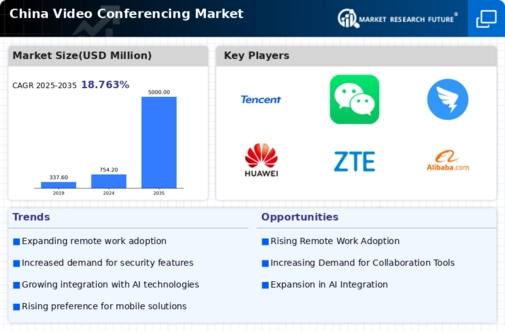Focus on Enhanced User Experience
The emphasis on enhancing user experience is a critical driver in the video conferencing market. Companies are investing in user-friendly interfaces and features that cater to diverse user needs, including virtual backgrounds, real-time collaboration tools, and integration with other software applications. In 2025, it is expected that user experience improvements will lead to a 25% increase in user satisfaction ratings for video conferencing platforms. This focus on usability is essential for attracting and retaining customers in a competitive market. The video conferencing market is thus adapting to these demands, ensuring that platforms are not only functional but also enjoyable to use, which is vital for long-term success.
Advancements in Internet Infrastructure
The rapid advancements in internet infrastructure across China are significantly impacting the video conferencing market. With the rollout of 5G technology, users are experiencing faster and more reliable internet connections, which enhances the quality of video calls. This improvement in connectivity is expected to increase user adoption rates, as high-definition video conferencing becomes more accessible. In 2025, it is estimated that over 60% of urban areas in China will have access to 5G networks, facilitating smoother and more efficient virtual meetings. Consequently, the video conferencing market is likely to benefit from this technological evolution, as businesses and individuals seek to leverage improved internet capabilities for enhanced communication.
Growing Demand for Remote Collaboration
The increasing need for effective remote collaboration tools is a primary driver in the video conferencing market. As businesses in China continue to embrace flexible work arrangements, the demand for video conferencing solutions has surged. In 2025, the market is projected to grow by approximately 15% annually, reflecting a shift in workplace dynamics. Companies are investing in advanced video conferencing technologies to enhance communication and collaboration among remote teams. This trend is particularly evident in sectors such as education and technology, where virtual meetings have become essential for project management and team coordination. The video conferencing market is thus witnessing a robust expansion, driven by the necessity for seamless interaction in a geographically dispersed workforce.
Rising Popularity of E-Learning Platforms
The surge in e-learning platforms in China is a notable driver for the video conferencing market. Educational institutions are increasingly adopting video conferencing tools to facilitate remote learning and enhance student engagement. In 2025, it is projected that the e-learning market will grow by 20%, with video conferencing playing a crucial role in delivering interactive lessons and virtual classrooms. This trend is particularly relevant in higher education, where universities are leveraging video conferencing to connect with students across different regions. The video conferencing market is thus experiencing a significant boost from the educational sector, as institutions seek to provide quality learning experiences through innovative technology.
Increased Investment in Digital Transformation
The ongoing digital transformation initiatives across various sectors in China are driving growth in the video conferencing market. Organizations are increasingly recognizing the importance of integrating digital tools to improve operational efficiency and customer engagement. In 2025, it is anticipated that investments in digital technologies will reach approximately $200 billion, with a significant portion allocated to communication tools like video conferencing. This trend indicates a shift towards more interactive and engaging customer experiences, as businesses adopt video conferencing solutions to facilitate virtual consultations and support. The video conferencing market is thus positioned to thrive as companies prioritize digital solutions to remain competitive in an evolving landscape.

















Leave a Comment